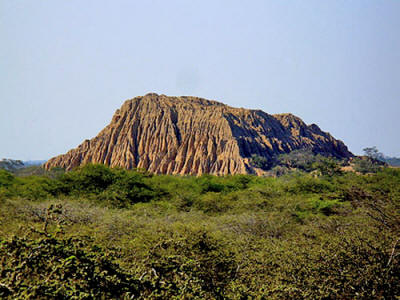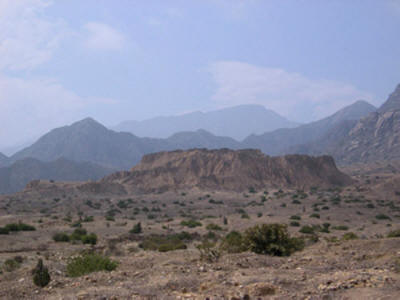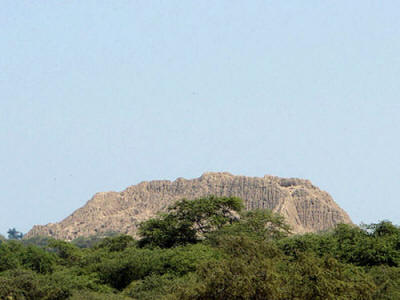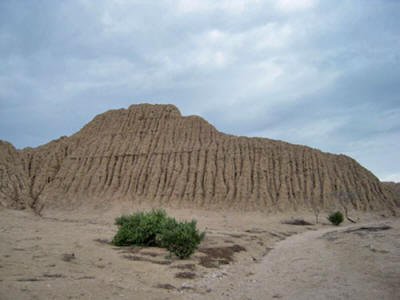|
Sections of this article were excerpted from “The New Pyramid Age” from PhilipCoppens Website
Batan Grande
The Lambayeque Valley is the largest valley of the North Coast of Peru, located between the Pacific Ocean and the Andes mountain range. It has no less than three pyramid cities, which together have a stunning total of 250 pyramids.
The three cities were built in succession of each other, each abandoned before a new one was built.
The city had 34 pyramids, including the Huaca de Oro (Pyramid of Gold), in front of which a series of royal tombs were located.
The pyramids are now badly eroded, due to El Niño rains in 1982 and 1998. But the biggest destruction to the site was man-made when in ca. 1100 AD, the pyramid was burnt and the town abandoned, to be succeeded by Tucume, from 1100 AD until 1500 AD.
The local shamans are also the record keepers of the legends, including one legend recorded by Father Cabello de Balboa in 1586 AD. It relates how Cala, a grandson of Naylamp, the founder of the Lambayeque royal dynasty, declared that Tucume would become the new metropolis for his people.
Cala seems to have been an exile from
Batan Grande.
The Huaca Larga, or the Long Pyramid, is the longest adobe structure known to date. It measures 700 meters in length, from the foot of La Raya Mountain to the short, straight access ramp on the north end.
It is 280 meters wide, and thirty meters tall.
Originally, it was a freestanding platform, but it was remodeled into is current shape by adding the step pyramid on top.
Long corridors and dividing walls partition the complex, and researchers have identified a northern, possibly public, ceremonial area and a southern area devoted to cooking and manufacturing.
Apparently, the Chimú tried to convert
Huaca Larga into a structure that resembled the vast
adobe city of Chan Chan, found near
Trujillo.
The most exciting discoveries are linked to Heyerdahl’s inquiry regarding possible ocean travel and boatbuilding by early inhabitants of Tucume. Among the finds were stunning friezes depicting birdmen piloting reed boats amid anthropomorphic waves.
Four burial chambers were found in the 600 meter long Huaca Larga pyramid. Inside these chambers, the bodies of nineteen female weavers, between the ages of ten and thirty and because of their ages assumed to have been sacrificed, were found. These date from the Inca period (1470-1532 AD). The weaving of delicate textiles, an activity that the Inca often entrusted to consecrated women, was therefore practiced at Huaca Larga and may well date back to what archaeologists have labelled Chimu period (1100-1400 AD).
It underlines that though archaeologists
and historians have neatly divided Peruvian history in various
“cultures”, the sites show continuity in use, with one culture not
abandoning a sacred site and constructing its own, but merely
“taking over” the management of the site.
It would therefore take thousands of people to complete one pyramid, but there are no less than 26 in total in Tucume alone, and more than 200 across the entire valley!
Pyramid building would thus have been an all-consuming task for the people of this valley.
On top of one pyramid, the remains of a 35 year old man have been discovered. He wore jewellery and a feather headdress, clearly a member of a governing elite, either in a political and/or religious sense.
As mentioned, Purgatorio (purgatory) is still the name by which the local people refer to the complex today. But despite this “Christian warning”, local shaman healers (“curanderos”) continue to invoke the power of Tucume and the central La Raya Mountain in their rituals, assisted by shamanic techniques and the psychoactive San Pedro cactus, holding weekly rituals which researchers believe have been going on since Inca times - if not before.
Its official name, Cerro La Raya, is derived from a ray fish that according to legend lives within the hill.
That the mountain of the gods was
off-limit to humans explains why the people “had” to build a pyramid
- a replica mountain which they were allowed to access.
To fully understand the Tucume complex, we need to look at the “Temple of the Sacred Stone”, which is a small, unpretentious, rectangular U-shaped structure to the east of Huaca Larga.
It is considered a major temple that pilgrims had to pass by before entering the complex. The walled roadway system of this section of the Lambayeque valley leads straight to this temple, and then onwards to Huaca Larga.
The revered object of this temple appears to have been a large, upright boulder in the middle of the one-room building: the “sacred stone”. Archaeologists “officially” do not know what it represents, but in my humble opinion, it represents the “navel of the world”, identifying this site as a sacred centre. Such navel stones have been found in various religious centers throughout the ancient world, with the navel stone of Delphi probably the most famous example.
As the Cerro La Raya was off-limits for humans, the “sacred stone” was used as the mountain’s physical presence in the sacred precinct, the only part of the apu that they were allowed to come close to, if not touch. The small “Piedra Sagrada” represented the larger omphalos of “Cerro Purgatorio”.
The Spanish Conquistadors probably understood the local rituals and compared them with their own christian upbringing. Purgatory and fire go hand in hand in the Christian tradition, where purgatory is a state of existence, the domain of the dead who were with sin and where the fire purges the soul of its sin.
In 2 Macchabees 12: 43, 46 the Jewish practice of praying for the dead stated that,
The sins of these dead were removed by what was believed to be a long, slow “simmer” of fire. St Cyprian and St Augustine spoke of purification by fire, which “purges away all sin by suffering.”
Is it coincidence, or design, that elsewhere, pyramids - by their very name - are linked with fire?
Let us also note that when one complex was abandoned, the structures on top of the pyramids were burnt, as if to literally obliterate the “sins” of a previous era and move to a new temple complex.
The people who built the pyramids did it themselves and to themselves and archaeologists, like Bernarda Delgado, the Tucume Archaeology Director, do not know the reason why.
Could it be that the reason was religious and linked with the New Fire Ceremony? It is clear that the inhabitants of these complexes burnt the top of the carefully built pyramids and then left.
“Purging” the old site may indeed be the
true answer to the burning of the complexes and the Spanish
Conquistadors, in identifying the site as purgatory, may have
understood far more than we would initially give them credit for.
|




